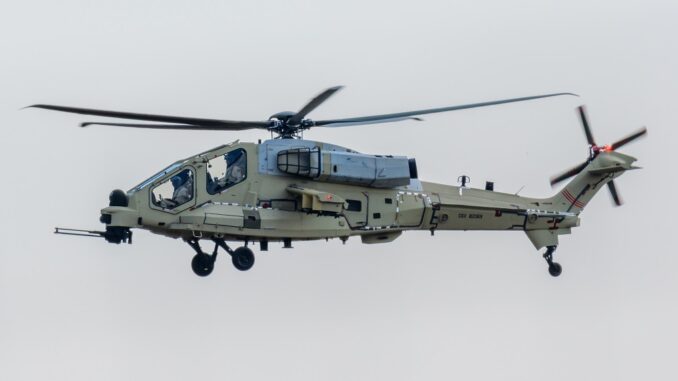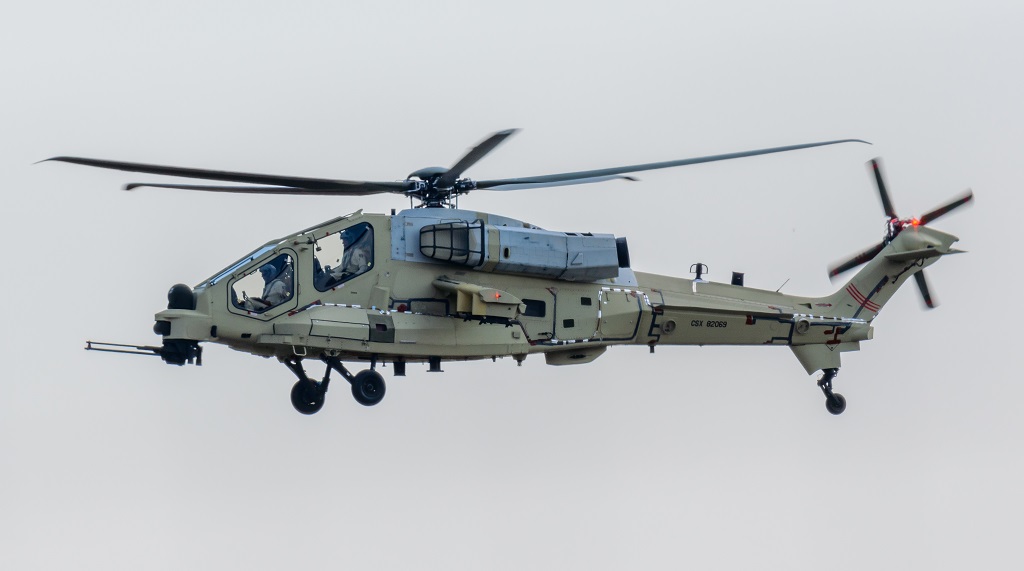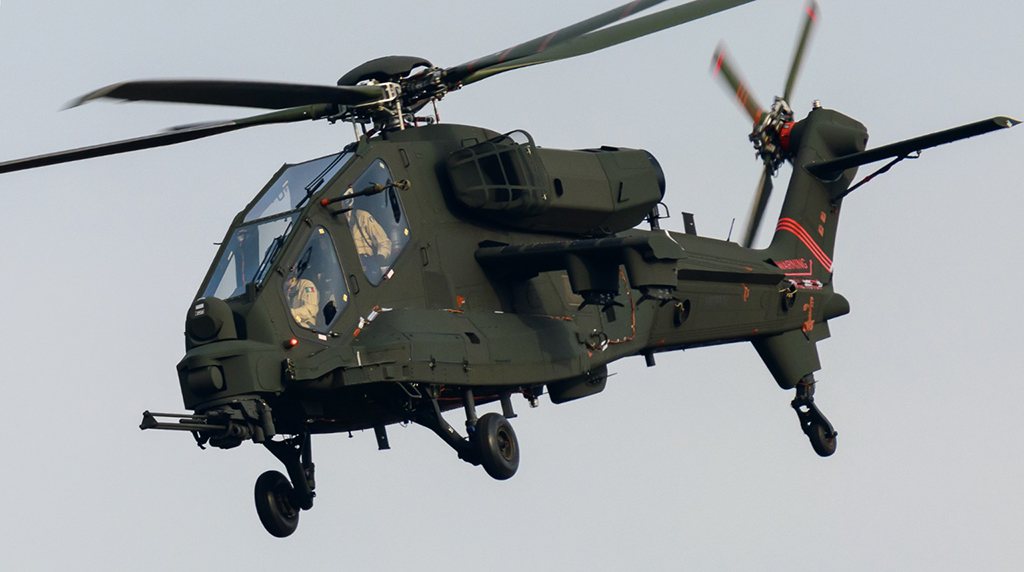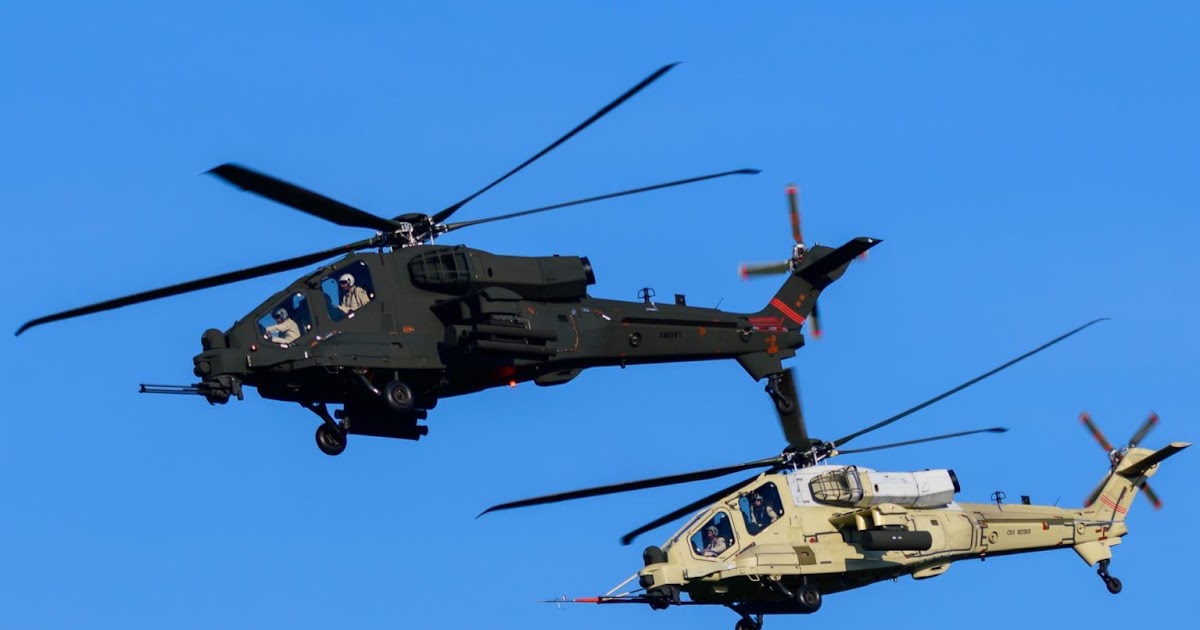
The first prototype of the Leonardo AW249 next-generation attack helicopter flew for the first time on August 12, 2022, from the company’s plant in Vergiate. The helicopter, formally designated as AW249 NEES (Nuovo Elicottero da Esplorazione e Scorta / New Exploration and Escort Helicopter), will replace the AW129 Mangusta, which has been in service with the Italian Army since the 1990s and upgraded throughout the years until the current AH-129D variant.
The helicopter flew with just its primer paint and the experimental serial CSX82069. On the fuselage and tail boom we can see some lines created with grey and red tape, with the latter possibly being used to attach strain sensors on the surface to monitor the stress on the airframe during the flight. Also, the helicopter has already been equipped with the TM197B 20 mm cannon and the Rafael Toplite targeting system inherited from the Mangusta.
Leonardo has been working on the project since 2017, when the Italian Ministry of Defence initiated the NEES program, which includes one prototype, three pre-serial production helicopters and a need for up to 48 operational helicopters. While at Farnborough air show, Stefano Villanti, senior vice-president of sales at Leonardo Helicopters, said development of the AW249 has been “progressing like clockwork” against the Italian Army’s timeline. The Army plans to retire the AH-129 from 2025.
“The AW249 meets emerging requirements for a latest generation combat helicopter to operate in a rapidly evolving battlespace over the next 30 years”, according to the manufacturer’s website. “The only new combat helicopter currently in design, it will combine advanced technologies, outstanding performance and high survivability, together with low operating costs.”
As we just mentioned, the AW249 will be tailored to the future battlespace. In order to adapt to the rapidly evolving scenarios, the helicopter will fuse open systems architecture to allow quick upgrades and growth capabilities, state-of-the-art communications and an advanced battlespace management system. Also, because of the increasing need to team with other platforms in network-centric operations, the AW249 will feature manned-unmanned teaming (MUM-T) capabilities.
The interoperability and situational awareness of the helicopter will be boosted by C2 (Command and control) and C4 (command, control, communications, and computer) systems, together with Software Defined Radios for multi-band Line of Sight (LOS) e Beyond Line of Sight (BLOS) communications, Variable Message Format and Link-16 data links, photo and video transmission systems (like ROVER).
The situational awareness will also take advantage of obstacle and altimetric profile detection systems, as well as all the standard navigational aids, day, night and thermal vision systems and helmet mounted displays (HMD). The sheer amount of info will be reportedly displayed on large area displays (LAD) in both cockpits, as shown in concept images published in 2017.
The helicopter is powered by a pair of GE Aviation CT7-8E6 (T700) turboshaft engines, rated at 2,500hp (1,860kW) each and also includes dynamic components from the AW149 transport helicopter. The AW249 has been designed with a maximum take-off weight (MTOW) within the range of 7,500 – 8,000 kg (about the double of the AW129’s MTOW), with the ability to operate in both hot-and-high and cold weather conditions, with a cruising speed of 140kts and a three-hour endurance. The helicopter has been designed also with ship-borne operations in mind.
Thanks to its MTOW, the AW249 features a weapon payload which is reportedly doubled compared to the Mangusta. Six wing stations will be able to load air-to-ground and air-to-air missiles, unguided/guided rockets and external fuel tanks, in addition to the nose mounted 20 mm cannon. Like the cannon and the targeting system, the AW249 will also inherit the Spike anti-tank guided missiles.
Survivability is also at the top of the design priorities, with both ballistic tolerance (e.g. redundancy, separation of critical systems, dry run capability of drive system, armoured seats, ballistic tolerant fuel tanks) and crashworthiness (e.g. crashworthy airframe, seats and fuel tanks) features being integrated. The helicopter will feature a state-of-the-art self-protection suite, with the Italian Army reportedly selecting the fully digital Elettronica ELT-162 Radar Warning Receiver, the Elettronica ELT/577 Quiris Directed Infra-Red Counter Measure System (DIRCM) and the Leonardo Multi Aperture InfraRed (MAIR) Missile Warning System (MWS).
The aircraft also has some low detectability features to reduce both the radar cross section and infrared signature. Although it is not a stealth helicopter, these features will help to make the detection of the AW249 more difficult for the adversaries. However, the prototype doesn’t appear to have IR exhaust filters on the engines, which might be added later on during the flight test campaign. The helicopter might also include features from international Future Fast Rotorcraft programs.
While public info about the new attack helicopter are still limited, it is already attracting interest from possible export customers. According to some reports, Germany is already in talks with Leonardo and the Italian MoD about a possible replacement of the German Army’s Eurocopter Tiger helicopters with the AW249. Reports from the BSDA exhibition in Bucharest earlier this year also say that Romania is considering to acquire a number of AW249 helicopters.
Poland was also considered interested, as Leonardo signed in 2018a letter of intent (LOI) with the state-owned Polish Armaments Group (PAG) to collaborate on the AW249’s development. The Polish MoD is, in fact, looking to replace its Mi-24 Hind helicopters, however it has been announced earlier this year that the choice will be between the Boeing AH-64E Apache Guardian and Bell AH-1Z Viper.

The New AW249 Attack Helicopter Flies For The First Time
The helicopter will replace the AH-129D Mangusta in service with the Italian Army. The first prototype of the Leonardo AW249 next-generation attack






